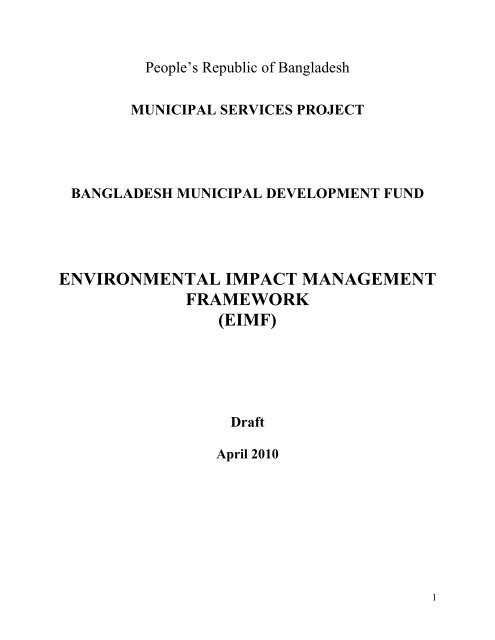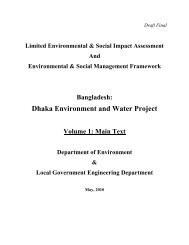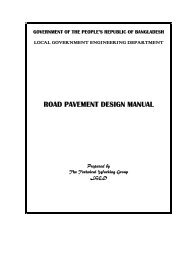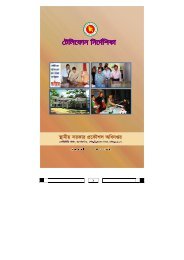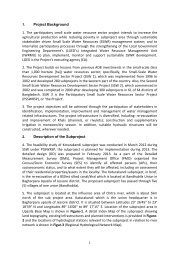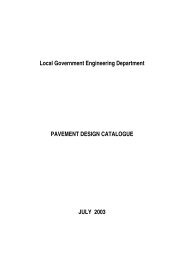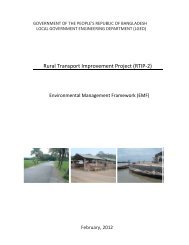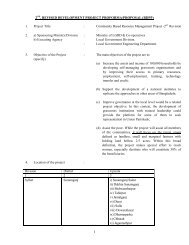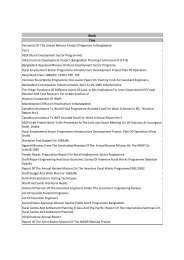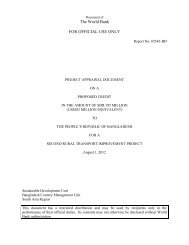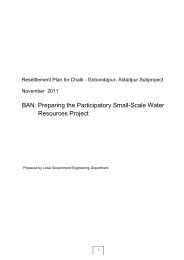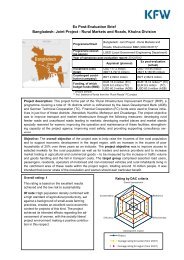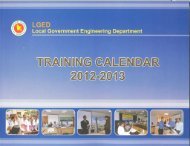environmental impact management framework (eimf) - LGED
environmental impact management framework (eimf) - LGED
environmental impact management framework (eimf) - LGED
Create successful ePaper yourself
Turn your PDF publications into a flip-book with our unique Google optimized e-Paper software.
People’s Republic of Bangladesh<br />
MUNICIPAL SERVICES PROJECT<br />
BANGLADESH MUNICIPAL DEVELOPMENT FUND<br />
ENVIRONMENTAL IMPACT MANAGEMENT<br />
FRAMEWORK<br />
(EIMF)<br />
Draft<br />
April 2010<br />
1
TABLE OF CONTENTS<br />
page<br />
List of Abbreviations 3<br />
A. OVERVIEW: PRINCIPLES AND RESPONSIBILITIES 4<br />
Status<br />
Objectives<br />
Principles<br />
B. RELEVANT POLICIES AND REGULATIONS 5<br />
Environmental Policies and Regulations of Bangladesh<br />
Environmental Categories<br />
World Bank’s Environmental Safeguard Policy<br />
C. APPLICATION OF ENVIRONMENTAL POLICIES AND RULES FOR MSP 7<br />
Project Description<br />
Environmental Screening<br />
Initial Environmental Examination<br />
Environmental Impact Assessment<br />
Environmental Management Plan<br />
Reporting and Monitoring<br />
D. CONSULTATION, DISCLOSURE, DISPUTES, AND APPROVAL 9<br />
Stakeholder Consultation<br />
Disclosure<br />
Grievance Redress<br />
Approval<br />
ANNEX 1. ENVIRONMENTAL SCREENING FORM<br />
ANNEX 2. GUIDELINE FOR INITIAL ENVIRONMENTAL EXAMINATION<br />
ANNEX 3. ENVIRONMENTAL MANAGEMENT OF CONSTRUCTION<br />
2
LIST OF ABBREVIATIONS<br />
BMDF Bangladesh Municipal Development Fund<br />
CBO - Community Based Organization<br />
CG - Community Group<br />
DEPC - Department of Environmental Pollution Control<br />
DOE - Department of Environment<br />
DPHE - Department of Public Health Engineering<br />
EA - Environmental Assessment<br />
ECA - Environmental Conservation Act<br />
ECC - Environmental Clearance Certificate<br />
ECR - Environmental Conservation Rules<br />
EIA - Environmental Impact Assessment<br />
EMP - Environmental Management Plan<br />
ES - Environmental Screening<br />
ESA - Environmentally Sensitive Area<br />
EIMF - Environmental Impact Management Framework<br />
ESS - Environmental and Social Safeguards<br />
GOB - Government of Bangladesh<br />
IEE - Initial Environmental Examination<br />
LEA - Limited Environmental Assessment<br />
MoEF - Ministry of Environment and Forest<br />
MSP<br />
Municipal Services Project<br />
NEMAP - National Environmental Management Action Plan<br />
NGO - Non-Governmental Organization<br />
NOC<br />
No Objection Certificate<br />
NSDWSSP - National Safe Drinking Water Supply and Sanitation Policy<br />
NWMP - National Water Management Plan<br />
OD - Operational Directives (of the World Bank)<br />
OP - Operational Policies (of the World Bank)<br />
OM - Operational Manual<br />
PAP - Project Affected Peoples<br />
PFS - Project Feasibility Study<br />
PSF - Pond Sand Filter<br />
SIMF - Social Impact Management Framework<br />
ULB<br />
Urban Local Body, i.e. Pourashava or City Corporation<br />
WB<br />
World Bank<br />
3
A. OVERVIEW: PRINCIPLES AND RESPONSIBILITIES<br />
1. Status. The preparation and implementation of subprojects of the Municipal Services Project<br />
(MSP) are the responsibility of the Urban Local Bodies (ULBs) subject to review, appraisal, and<br />
support by the Bangladesh Municipal Development Fund (BMDF) and the World Bank. These<br />
responsibilities include the assessment and <strong>management</strong> of <strong>environmental</strong> and social <strong>impact</strong>s that<br />
may arise under subprojects financed through BMDF. This Environmental Impact Management<br />
Framework (EIMF) specifies the responsibilities, procedures, and models for dealing with<br />
<strong>environmental</strong> <strong>impact</strong>s of the subprojects financed through the BMDF. Together with the Social<br />
Impact Management Framework (SIMF) dated September 2007, this EIMF replaces the<br />
Environmental and Social Management Framework for MSP dated August 1998 for the BMDFfinanced<br />
subprojects.<br />
2. Objectives. The EIMF provides general policies, guidelines, and procedures for integration<br />
into selection, design, implementation, and monitoring of the subprojects. Its objective is to help<br />
ULBs and BMDF to ensure that activities under the project will:<br />
• Enhance <strong>environmental</strong> outcomes of the activities implemented under individual<br />
subprojects;<br />
• Identify and mitigate adverse <strong>impact</strong>s that subprojects might cause on the environment;<br />
and<br />
• Ensure compliance with the relevant policies and regulations of the Government as well<br />
as the World Bank’s <strong>environmental</strong> safeguard policies.<br />
3. Principles. In view of these objectives, <strong>environmental</strong> assessment and mitigation of negative<br />
<strong>impact</strong>s shall be an integral part of the selection, design, implementation, and monitoring of<br />
subprojects. These include the following, for which standards, procedures, and responsibilities<br />
are specified in this EIMF.<br />
• All proposed subprojects shall be subjected to <strong>environmental</strong> screening in order to<br />
identify all potential <strong>environmental</strong> issues, and appropriate assessment and mitigation<br />
measures should be undertaken appropriate for the potential issues thus identified.<br />
• Alternatives shall be considered, including not undertaking the subproject, to evaluate<br />
<strong>environmental</strong> <strong>impact</strong>s along with other benefits and costs and to ensure that negative<br />
<strong>environmental</strong> <strong>impact</strong>s are minimized.<br />
• No subprojects shall be undertaken without the approvals required under the relevant<br />
laws and rules of Bangladesh as well as the World Bank policy.<br />
• ULBs will undertake community consultation about their objectives, scopes, and any<br />
temporary and permanent <strong>environmental</strong> implications when selecting and designing a<br />
subproject, and about the <strong>impact</strong>s and mitigation measures during the subproject<br />
implementation. Community consultation should in particular include the people who<br />
might be affected directly.<br />
• The <strong>environmental</strong> <strong>impact</strong>s and mitigation measures should be an integral part of the<br />
4
eview and monitoring of subprojects through the reporting chain, involving the ULB,<br />
contractors, BMDF, and the World Bank.<br />
• BMDF and its consultants should ensure the completeness and quality of <strong>environmental</strong><br />
screening, assessment and <strong>management</strong> through subproject appraisal, supervision, and<br />
technical assistance processes.<br />
B. RELEVANT POLICIES AND REGULATIONS<br />
1. Environmental Regulations of Bangladesh that are most relevant to <strong>environmental</strong><br />
<strong>management</strong> under MSP are Bangladesh Environmental Conservation Act (ECA), 1995 and its<br />
implementing regulation, Environment Conservation Rules (ECR), 1997. These need to be<br />
observed under MSP. Their salient features are described in some detail below.<br />
2. Environment Conservation Act 1995 (ECA 1995) is currently the main act governing<br />
<strong>environmental</strong> protection in Bangladesh, which replaced the earlier environment pollution<br />
control ordinance of 1992 and provides the legal basis for Environmental Conservation Rules,<br />
1997 (ECR'97). The main objectives of ECA’95 are: conservation of the natural environment<br />
and improvement of <strong>environmental</strong> standards, and control and mitigation of <strong>environmental</strong><br />
pollution. The main strategies of the act can be summarized as:<br />
• Declaration of ecologically critical areas, and restriction on the operation and process,<br />
which can be continued or can not be initiated in the ecologically critical areas.<br />
• Regulation in respect of vehicles emitting smoke harmful for the environment.<br />
• Environmental clearance.<br />
• Remedial measures for injury to ecosystem<br />
• Regulation of the projects and other development activities - discharge permit.<br />
• Promulgation of standards for quality of air, water, noise and soil for different areas for<br />
different purposes.<br />
• Promulgation of standard limit for discharging and emitting waste.<br />
• Formulation and declaration of <strong>environmental</strong> guidelines.<br />
3. The Act is implemented by Department of Environment (DOE), under the Ministry of<br />
Environment and Forest. Before going for any new development project, the project proponent<br />
must have to take Environmental Clearance from DOE. The procedures to take such clearance are<br />
in place. Failure to comply with any part of ECA'95 may result in punishment by a maximum of 10<br />
years imprisonment or a maximum fine of Tk. 1000,000 or both.<br />
4. Environmental Conservation Rules 1997 consists of a set of the relevant rules to<br />
implement the ECA’ 95, which specify:<br />
• categorized list (green, orange and red) of the projects,<br />
• procedure to take <strong>environmental</strong> clearance,<br />
• ambient standards in relation to water pollution, air pollution and noise, as well as<br />
permitted discharge/emission levels of water and air pollutants and noise by projects.<br />
5
5. Environmental Categories. ECR 97 classifies projects by potential <strong>environmental</strong> <strong>impact</strong><br />
and assign different assessment and <strong>management</strong> requirements as follows:<br />
Green List projects are those with positive <strong>environmental</strong> <strong>impact</strong>s or negligible negative<br />
<strong>impact</strong>s such as plantation and nursery. Clearance for these is obtained on the basis of<br />
project description, initial screening and No Objection Certificate (NOC) by the local<br />
authority.<br />
Orange List projects fall into two categories.<br />
Orange A projects are those with minor and mostly temporary <strong>environmental</strong> <strong>impact</strong>s for<br />
which there are standard mitigation measures, such as the installation of tube wells, pond<br />
sand filter (PSF), tank/reservoir, sanitary latrines etc. Application for DOE’s<br />
<strong>environmental</strong> clearance requires general information, a feasibility report, a process flow<br />
diagram and schematic diagrams of facilities, <strong>environmental</strong> screening form, NOC from<br />
local authority.<br />
Orange B projects are those with moderately significant <strong>environmental</strong> <strong>impact</strong>s for which<br />
mitigation measures are easily identified, such as construction/re-construction of earthen<br />
roads, culverts, community center, office building for general services, re-excavation of<br />
canal, repairing embankment, and school field, etc. These require Environmental<br />
Clearance Certificate from DOE, for which an Initial Environmental Examination (IEE)<br />
report, Environmental Management Plan, along with the information and papers specified<br />
for Category A projects.<br />
Red List projects are those which may cause ‘significant adverse’ <strong>environmental</strong> <strong>impact</strong>s<br />
such as the construction of bridge, industrial factories, flood shelter, embankment, water<br />
control structure, etc. They require IEE report to obtain the Site Clearance Certificate,<br />
and subsequently a full EIA report for ECC, along with the information required for other<br />
Categories.<br />
6. Environmental standards also promulgated under the Environment Conservation Rules<br />
1997 are prescribed for varying water sources, ambient air, noise, odor, industrial effluent and<br />
emission discharges, vehicular emission, etc. with the main aim of limiting the volume and<br />
concentrations of pollution discharged into the environment. A number of surrogate pollution<br />
parameters like Biochemical Oxygen Demand, or Chemical Oxygen Demand; Total Suspended<br />
Solids, etc. are specified in terms of concentration and/or total allowable quality discharged in<br />
case of waste water and solid waste. Additionally specific parameters are specified such as<br />
phenol, cyanide, copper, zinc, chromium, various types of particulate, sulfur dioxide, nitrogen<br />
oxides, volatile organic compounds and other substances.<br />
7. World Bank’s Environmental Safeguard Policy. The Bank requires <strong>environmental</strong><br />
assessment (EA) and Social Assessment of projects proposed for Bank financing to help ensure<br />
that they are both socially and <strong>environmental</strong>ly sound and sustainable, and thus to improve<br />
decision making. The World Bank's <strong>environmental</strong> assessment policy and recommended<br />
6
processing are described in Operational Policy (OP)/Bank Procedure (BP) 4.01:<br />
Environmental Assessment. This policy is considered to be the umbrella policy for the Bank's<br />
<strong>environmental</strong> "safeguard policies" which include policies on: Natural Habitats (OP 4.04),<br />
Forests (OP 4.36), Pest Management (OP 4.09), Physical Cultural Resources (OP 4.11)), and<br />
Safety of Dams (OP 4.37).<br />
8. Environmental Assessment (OP 4.01) is required of all projected financed by WB to<br />
identify, avoid, and mitigate the potential negative <strong>environmental</strong> <strong>impact</strong>s associated with Bank<br />
lending operations. In World Bank operations, the purpose of Environmental Assessment is to<br />
improve decision making, to ensure that project options under consideration are sound and<br />
sustainable, and that potentially affected people have been properly consulted. EA is seen as a<br />
process whose breadth, depth, and type of analysis depend on the nature, scale, and potential<br />
<strong>environmental</strong> <strong>impact</strong> of the proposed project. EA evaluates a project's potential <strong>environmental</strong><br />
risks and <strong>impact</strong>s in its area of influence; examines project alternatives; identifies ways of<br />
improving project selection, siting, planning, design, and implementation by preventing,<br />
minimizing, mitigating, or compensating for adverse <strong>environmental</strong> <strong>impact</strong>s and enhancing<br />
positive <strong>impact</strong>s; and includes the process of mitigating and managing adverse <strong>environmental</strong><br />
<strong>impact</strong>s throughout project implementation. EA takes into account the natural environment (air,<br />
water and land); human health and safety; social aspects (involuntary resettlement, indigenous<br />
peoples and physical cultural resources); and transboundary and global <strong>environmental</strong> aspects.<br />
The borrower is responsible for carrying out the EA and the Bank advises the borrower on the<br />
Bank’s EA requirements.<br />
9. The Bank classifies the proposed projects into three major categories, depending on the<br />
type, location, sensitivity, and scale of the project and the nature and magnitude of its potential<br />
<strong>environmental</strong> <strong>impact</strong>s as shown in the following Table.<br />
Environmental Classification of Projects Supported by the World Bank<br />
Category Potential Environmental Impacts EA Requirements<br />
Category<br />
A<br />
Category<br />
B<br />
The project is likely to have significant<br />
adverse <strong>environmental</strong> <strong>impact</strong>s that are<br />
sensitive, diverse, or unprecedented. These<br />
<strong>impact</strong>s may affect an area broader than the<br />
sites or facilities subject to physical works<br />
The project has potential adverse<br />
<strong>environmental</strong> <strong>impact</strong>s on human<br />
populations or <strong>environmental</strong>ly important<br />
areas—including wetlands, forests,<br />
grasslands, and other natural habitats—are<br />
less adverse than those of Category A<br />
projects. These <strong>impact</strong>s are site-specific;<br />
few if any of them are irreversible; and in<br />
most cases mitigation measures can be<br />
designed more readily than for Category A<br />
projects.<br />
Full EA and EMP<br />
EA is narrower than that of<br />
Category A EA. Like Category<br />
A EA, it examines the project's<br />
potential negative and positive<br />
<strong>environmental</strong> <strong>impact</strong>s and<br />
recommends any measures<br />
needed to prevent, minimize,<br />
mitigate, or compensate for<br />
adverse <strong>impact</strong>s and improve<br />
<strong>environmental</strong> performance.<br />
7
Category<br />
C<br />
The project is likely to have minimal or no<br />
adverse <strong>environmental</strong> <strong>impact</strong>s<br />
Screening only<br />
C. APPLICATION OF ENVIRONMENTAL POLICIES AND RULES FOR MSP<br />
10. Project Description. The subprojects which have been preliminarily appraised for<br />
support with the additional financing of MSP include the construction or upgrading of roads,<br />
piped water supply, water production tube wells, overhead tanks, pump house, drains, street<br />
lighting, kitchen markets, community centers, office buildings, children’s park, and a slaughter<br />
house in 56 municipalities at a total aggregate cost of about $40 million. Kitchen markets<br />
consist of a shed or two for sorting and wholesale of mostly agricultural produce, and often large<br />
space for retailers who either sit in the open or in makeshift shelters. Most of the markets<br />
operate only during a limited period of time, a few times a week or a few hours each day. The<br />
proposed slaughter house rehabilitation involves one 9m by 7.3m at a cost of about $5,000, but<br />
its <strong>environmental</strong> <strong>impact</strong>s needs further examination.<br />
11. According to the initial screening, which is subject to review, all subprojects would fall<br />
under Orange A or Orange B category under ECR ’97 and World Bank’s <strong>environmental</strong> category<br />
B. However, some of the subprojects require further <strong>environmental</strong> examination and may be<br />
reclassified. For example, the children’s park may be classified as Green, and the slaughter<br />
house can have potential <strong>environmental</strong> <strong>impact</strong> that requires full EA and EMP.<br />
12. ECR 1997 requires three tiers of EA:<br />
• Screening: required of all projects;<br />
• Initial Environmental Examination (IEE): required of Orange B and Red category<br />
projects; and<br />
• (full) Environmental Impact Assessment (EIA): required of Red category projects.<br />
13. Environmental Screening. As seen above, the screening has been conducted for most<br />
of the subprojects to be financed with the additional financing, but they would be reviewed by<br />
BMDF and WB before the final appraisal and approval of the subprojects. The Environmental<br />
Screening Form is provided in Annex 1.<br />
14. Initial Environmental Examination. Under the ECR classification, many of the<br />
proposed subprojects such as tube-wells would be classified as Orange A, requiring no further<br />
EA. They would, however, be considered Category B under the WB <strong>environmental</strong><br />
classification, and therefore will be required to conduct IEE which is similar to the “limited EA”<br />
required by the WB. A sample outline of the IEE report is attached as Annex 2.<br />
15. Environmental Impact Assessment. While none of the currently identified subprojects<br />
appears to meet the standards to be considered as Red Category under ECR 97 or Category A<br />
under the WB classification, there is a possibility that IEE of some subprojects may prompt<br />
reclassification and requirement for full EIA. In view of the short implementation period, they<br />
would best be not considered for the additional financing.<br />
8
16. Environmental Management Plan. For the subprojects under consideration, negative<br />
<strong>environmental</strong> <strong>impact</strong>s are likely to be minor and the mitigation measures are easily identified<br />
and standard; for example, construction of properly sized and located culverts when building a<br />
road. They will differ by subproject, and need to be identified as part of the IEE. However, all<br />
of the subprojects involve construction activities and likely to involve common temporary<br />
<strong>environmental</strong> <strong>impact</strong>s. Mitigation measures for these common <strong>environmental</strong> <strong>impact</strong>s of<br />
construction are listed in Annex 3, which need to be incorporated in construction contracts.<br />
17. Reporting and Monitoring. Monthly report on the project progress shall be submitted<br />
by ULB including the compliance with the <strong>environmental</strong> <strong>management</strong> plan, and BMDF will<br />
submit a summary monthly report to WB within five weeks of the end of the month. The results<br />
will be used in a feedback loop to allow the involved agencies and the contractor to modify<br />
project implementation activities as and when required. BMDF will ensure that its supervision<br />
includes the verification of the monthly reports and monitoring of the <strong>environmental</strong><br />
<strong>management</strong> activities. The WB supervision mission will include <strong>environmental</strong> specialists<br />
when visiting subprojects with significant potential <strong>environmental</strong> issues. Environmental audit<br />
should be conducted periodically (e.g., yearly) to review the effectiveness of <strong>environmental</strong><br />
<strong>management</strong>.<br />
D. CONSULTATION, DISCLOSURE, DISPUTES, AND APPROVAL<br />
18. Stakeholder Consultation. During the subproject selection, design, and implementation<br />
ULBs should ensure to incorporate input from the community, especially the people who are<br />
directly affected, to reflect their preferences as well as utilize their local knowledge in designing<br />
and supervising the subproject. This includes <strong>environmental</strong> screening and examination as well<br />
as the implementation of mitigation measures.<br />
19. Disclosure. In order to ensure the stakeholder consultation, full information of the<br />
subproject should be disclosed and made accessible in ULB offices. The designs and<br />
<strong>environmental</strong> mitigation measures should be publicly posted at the construction site as has been<br />
the practice in the past subprojects financed by BMDF. In addition, ULBs will authorize the<br />
BMDF and WB to make the same information accessible to the public. BMDF and WB will also<br />
disclose the EIMF at their offices and web sites.<br />
20. Grievance Redress. ULBs will establish a procedure to answer subproject-related<br />
queries and address complaints, disputes, and grievances about any aspect of the subproject,<br />
including disagreements regarding the assessment and mitigation of <strong>environmental</strong> <strong>impact</strong>s. For<br />
the purpose, a Grievance Redress Committee (GRC) will be formed in each ULB with<br />
memberships (below) to ensure proper presentation of complaints and grievances, as well as<br />
impartial hearings and transparent decisions. Membership composition for GRCs in CHT<br />
municipalities will take into account any traditional conflict resolution arrangements that IP<br />
communities may practice.<br />
Composition of Grievance Redress Committee:<br />
9
ULB Chairman<br />
Convenor<br />
Representative of BMDF<br />
Member<br />
Representative of a Local/National NGO<br />
Member<br />
Headmaster of the local High School<br />
Member<br />
Headmaster of the local Primary School<br />
Member<br />
Representative of Municipal Business Community Member<br />
CEO/Secretary of the ULB<br />
Member Secretary<br />
If the complainant is female, the Committee will include a female Ward Commissioner.<br />
21. If grievance resolution attempts at the ULB fail, the ULB will refer the complaints to<br />
BMDF along with the minutes of the hearings. BMDF will provide an independent arbitrator or<br />
expert to conduct further hearings, after obtaining agreement from both sides that the decision<br />
would be binding.<br />
22. Approval. The implementing ULB will be required to obtain necessary <strong>environmental</strong><br />
clearances and its annual renewal from DOE. BMDF consultants will provide assistance to ULB<br />
in ensuring inclusion of all necessary documents and quality of information.<br />
23. EIMF and its revision will be subject to review and formal no objection by the Bank.<br />
Appraisal of <strong>environmental</strong> safeguard issues for each subproject as well as <strong>impact</strong> mitigation<br />
plans, wherever required and prepared, will be subject to review and clearance by BMDF and<br />
WB in accordance with the EIMF. Whenever requested, BMDF will provide the Bank with<br />
copies of the Environmental Screening Form and Appraisal Forms filled in for all subprojects by<br />
ULBs and the consultants.<br />
10
ENVIRONMENTAL SCREENING FORM FOR SUBPROJECTS<br />
ANNEX 1<br />
[This form is to be filled in by ULBs and sent to BMDF with the subproject financing requests]<br />
A. IDENTIFICATION<br />
1. Name of Municipality: ……………………………… Name of District:……….…………<br />
2. Name/Location of Subproject: .…………………...….………….……………….………....………<br />
3. Scope of Subproject: [ ] New construction [ ] Improvement/Expansion [ ] Repair/Renovation<br />
4. Description of the physical works: ..……………………………………………………………………....<br />
…………………………………………………………………………………………….……………..<br />
……………………………………………………………………………………………….…………..<br />
…………………………………………………………………………………………….……………..<br />
………………………………………………………………………………………………….………..<br />
5. Screening Date: ……………………...<br />
B. PARTICIPATION IN SCREENING<br />
6. Names of ULB members & officials participated in this screening: ………………………………..…<br />
……………………………………………………………………………………………………...........<br />
…………………………………………………………………………………………………………...<br />
7. Names of Experts who participated in this screening<br />
8. Names and address of community members, including would-be affected persons and businesses,<br />
participated in this screening:<br />
..……………………………………………………………………………………………………<br />
……………………………………………………………………………………………………...........<br />
……………………………………………………………………………………………………...........<br />
11
C. POTENTIAL ENVIRONMENTAL IMPACTS<br />
Potential Impacts<br />
Yes/No/Temporary/Comment<br />
Change or destroy natural environment, grass land or wetland<br />
Take farm land<br />
Involve tree cutting<br />
Obstruct natural water flow<br />
Produce waste that pollutes soil<br />
Produce waste that pollutes water<br />
Produce air pollution<br />
Increase dusts<br />
Discharge pathogens or chemicals to air or water<br />
Other potential negative <strong>impact</strong>s<br />
Environmental concerns expressed by communities/organizations about the works proposed under the<br />
under the subproject which are not included above:<br />
…………………………………………………………………………………………<br />
…………………………………………………………………………………………………………………………<br />
…………………………………………………………………………………………………………………………<br />
…………………………………………………………………………………………………………………………<br />
…………………………………………………………………………………………………………………………<br />
…………………………………………………………………………………………………………………………<br />
12
…………………………………………………………………………………………………………………………<br />
The community and organizations perceive the overall <strong>environmental</strong> outcomes of the subproject:<br />
[ ] Positive<br />
[ ] Negative<br />
[ ] Neither positive nor negative<br />
This Screening Form has been filled in by:<br />
Name: ……………………………………………......<br />
Signature: ………………………………………...….<br />
Designation: …………………………..…..<br />
Date: …………………...<br />
Name & Signature of Participants in Screening:<br />
Name Signature Date<br />
1. ………………………………………………….. …………………………… ………………<br />
2. ………………………………………………….. …………………………… ………………<br />
3. ………………………………………………….. …………………………… ………………<br />
4. ………………………………………………….. …………………………… ………………<br />
5. ………………………………………………….. …………………………… ………………<br />
6. ………………………………………………….. …………………………… ………………<br />
7. ………………………………………………….. …………………………… ………………<br />
13
GUIDELINE FOR INITIAL ENVIRONMENTAL EXAMINATIONS<br />
Annex 2<br />
The Screening Form presented in Annex 1 filled in by ULB and checked by BMDF specialist will<br />
be the starting point of Initial Environmental Examination (IEE). The IEE should be conducted by<br />
<strong>environmental</strong> expert in consultation with local government and concerned residents and<br />
organizations. The examination will describe:<br />
• The current situation – baseline<br />
• Potential <strong>impact</strong>s of the proposed subproject, their extent and duration<br />
• Recommended mitigation measures and likely costs<br />
for each of the following <strong>environmental</strong> elements:<br />
• Topography<br />
• Climate<br />
• Air, Dust and Noise (The air, dust and noise level of the project area should be within<br />
limits set by the Environmental Quality Standards for emission and noise pollution under<br />
the ECR, 1997.<br />
• Soils. (Soil type, structure, and chemistry)<br />
• Hydrology and Water Quality<br />
• Ecological Environment<br />
Trees and Vegetation<br />
Fisheries<br />
Terrestrial and other Aquatic Inhabitants<br />
In particular, existence of endangered species in the general vicinity and the potential<br />
<strong>impact</strong>s on them have to be determined.<br />
14
ENVIRONMENTAL SAFEGUARDS FOR CONSTRUCTION<br />
Annex 3<br />
1. Noise level at the construction sites will be strictly enforced for preventing excessive noise<br />
to acceptable noise standard (Government of Bangladesh standard for commercial zone<br />
namely L90 of 70dBA).<br />
2. Provision will have been made to ensure that care will be taken during construction stage at<br />
nearby institution, hospital, mosque, other religious institution and settlement regarding<br />
dust, air and noise pollution.<br />
3. Use working method that minimizes gaseous, dust, or other airborne discharges; avoid<br />
work during high wind.<br />
4. Mechanical equipment and vehicles should be kept in good working order meeting<br />
emission and noise standards.<br />
5. Regular water should be sprayed during earthworks, construction of embankment, over<br />
newly constructed dry embankment and roads.<br />
6. Top soil from farm land should not be used as fill materials for earthworks.<br />
7. Drainage congestion / water logging problems should be prevented or minimized.<br />
8. Maintain cross-drainage at all times during construction.<br />
9. Polluted surface water due to construction work will damage the fish resource to some<br />
extends. Direct disposal of solid and liquid wastage into nearby water bodies should be<br />
prohibited, if possible.<br />
10. Cutting of trees should be only as permitted in advance.<br />
11. No trees will be felled unless they are directly in the path of the project road, unless they<br />
caused a barrier to construction or unless they create a safety hazard to the future operation<br />
of roads.<br />
12. Construction wastes, liquid or solid, should be collected and dumped in designated places<br />
according to pre-approved plan.<br />
13. Chemical and fuel will be stored in an impervious container clearly marked within a<br />
secured area, located away from residential or commercial establishments.<br />
14. Traffic congestion should be controlled by maintained free traffic flows always. Re-routing<br />
of traffic by construction of diversion roads (temporary bypass) may be maintained.<br />
15. Visible cautionary signs, barriers, including red lamp signalling at night, signal and flag<br />
persons to control the traffic should be provided.<br />
16. Personal Protective Equipment (PPE), e.g., ear protection gear, mask, goggles, safety<br />
shoes, etc. and First Aid Box should be provided to workers/project personnel, and no child<br />
labor (lower 14 years) personnel will be employed.<br />
17. Provide safe drinking water and proper sanitation facilities on site.<br />
15


